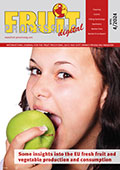Pear orange prices have been moving up since the beginning of the 2023/24 season in the in natura market. In January, values hit the record of Cepea series, which has started in 1994. In the first month of 2024, the price average was BRL 78.89 per 40.8-kilo box, moving up 16% compared to December/23 and 90% in relation to January/23, in real terms (values were deflated by IGP-DI Dec/23). Up until January/24, the highest value in real terms had been BRL 74.92/box, in November 1994.
This scenario of high prices is related to the limited supply. The production in the current crop is on average; however, low orange juice stocks increase the need to buy the raw material, reducing the orange supply in the in natura market.
As for the demand, players surveyed by Cepea say that it is firm, since temperatures are high, favoring the consumption of the fruit.
The pear orange supply is expected to continue limited in February, which is still considered offseason.
Industry
Prices for pear orange and late varieties for the industry had hit a real record in November. Since then, they have been renewing the record level of Cepea series, which has started in 1994. However, values are now moving down, considering the closing of new trades.
The price average for pear orange and late varieties for the industry was BRL 57.68 per 40.8-kilo box, harvested and delivered, in January, increasing 10% against the month before and 76% in relation to January 2023, in real terms.
Tahiti lime
Prices finished January at low levels, due to the peak season. The price average in January 2024 was BRL 13.56 per 27-kg box (harvested), for a decrease of 28% compared to the last month of 2023.
The tahiti lime supply is expected to continue high in February, due to rains in January, which can favor both the fruit development and the quality.
Orange prices increased in the Brazilian in natura market in the first fortnight of February. According to Cepea collaborators, frequent rains in the citrus belt (São Paulo State) favoured the quality (majorly the size) of oranges, making them suitable for sale in the in natura segment and allowing farmers to raise asking prices. Besides, rainfall also hampered the harvesting, limiting supply. In that scenario, values remained firm.
Usually, orange availability is not high in February – a month that may even be considered offseason –, however, as the 2021/22 season is late, supply is currently higher. Still, there is not an orange surplus in the domestic market, since processing at industries has been faster than usual this month.
So far, the number of early varieties to be harvested is not high – activities are expected to step up only from March onwards. However, supply may be constrained by the low flower set in the first blooming. Thus, the oranges currently available in the in natura market are mostly late varieties and pear oranges out of the ideal period.
TAHITI LIME – The production of tahiti lime is also being favoured by rains, however, farmers reported difficulties to harvest the fruits, which underpinned prices in the first fortnight of February, although it is currently the peak of harvest for tahiti lime in Brazil.
Despite the recent valuations for oranges and tahiti lime, Cepea collaborators have reported that the current economic scenario in Brazil is still constraining higher price rises. With high unemployment and inflation rates and lower income, the purchase power of many consumers is weak.
ESTIMATES – Although rains have favoured the quality of part of the fruits in orchards, they have not been enough to reverse all the damages caused by the drought to the oranges from the 2021/22 season.
According to data from Fundecitrus released on Feb. 10, the orange output (São Paulo + Triângulo Mineiro) in the 2021/22 season is still estimated at 264.14 million boxes of 40.8 kilograms, the same as that estimated in December, but 10 % below that forecast at the beginning of the season.
According to Somar/Climatempo (weather forecast agency), rainfall in SP between May/21 and Jan/22 was 25 % below the average for the period. In the Triângulo Mineiro, rains were 5 % higher than the average. Thus, orange growth was hampered, and the average fruit weight decreased. However, it is important to consider that the oranges harvested in February and in March 2022 are expected to be slightly larger, since they have been favoured by recent rains.
The volume harvested is still enough to replenish ending stocks at the processing plants in SP. According to CitrusBR, by the end of the 2021/22 season (in June 2022), the volume of Frozen Concentrate Orange Juice (Equivalent) stocked is expected to total 170 – 190 thousand tons, lower than the strategic level (250 thousand tons). It is important to consider that new estimates are supposed to be released until the end of February.
In this scenario, the harvest in 2022/23 needs to be large enough to raise stocks at least to the strategic level and thus prevent a world shortage of orange juice. Cepea calculations show that the orange output next season needs to total, at least, 330 million boxes in order to raise juice stocks to 250 thousand tons.
PROGRESS OF THE 2021/22 HARVESTING – According to Fundecitrus’ report, 82 % of the orange orchards had been harvested by mid-January/22, similar to that in the same period last season (81 %).
After the low production in the 2020/21 season, agents expect a limited orange crop in 2021/22 in São Paulo State and the Triângulo Mineiro, due to unfavorable weather conditions. This scenario tends to underpin orange prices in 2021.
The first estimates for the 2021/22 crop, released by the USDA in December/2020, indicate that the harvest in SP and the Triângulo Mineiro should total 315 million boxes of 40.8-kilos each, 17 % up from that in the previous season. Despite this recovery, this volume does not mean the productive potential of crops will be recovered because of the bad weather conditions in these regions.
Thus, a harvest of 315 million boxes is not high, and therefore may not be enough to totally offset orange juice inventories. On the other hand, it should favor farmers’ revenue for one more year, due to the firm industrial demand. It is worth to mention that these estimates may change, since it is still early to assess production, majorly this year. Fundecitrus should release estimates only in May 2021.
INVENTORIES – Data from CitrusBR indicate that initial inventories in the 2021/22 season may be from 240 to 280 thousand tons in July/21. Although this volume is not lower than the strategic level established, the small harvest in the 2021/22 season may limit the volume by the end of the season, in June 2022.
CONTRACTS WITH THE INDUSTRY – Deals for the new season have not been closed. As the volume produced is still uncertain, reasonable prices cannot be fixed either. Besides, in the 2020/21 season, many processors closed deals for the following crop. Thus, a higher volume of fruits from the coming season has already been sold. Still, prices are expected to be positive in this segment, since the demand from the industry should be high.
IN NATURA MARKET – Higher industrial demand should keep orange prices on the rise in the in natura market in 2021/22. As the 2021/22 crop is expected to be late again, the prices of early oranges should be favored, and quotes should be underpinned, since the pear orange crop may be late.
As the harvesting of the 2019/20 orange crop steps up in the orchards of São Paulo, citrus prices dropped in the in natura market in April – this scenario should still be observed in May. Besides the higher supply of all varieties, the share of fruits that have not reached the ideal maturation stage for the in natura sector yet increased pressure on quotes.
Concerning early oranges (rubi, hamlin and westin, for instance), trades have been closed since March. However, only in late April these fruits reached a maturation stage closer to that demanded by the in natura market. Thus, the average price for hamlin oranges last month was 23.78 BRL per 40.8-kilo box, on tree, 14 % down compared to that in March.
As for pear oranges, the first fruits from the 2019/20 crop that were harvested had lower quality for the in natura sector, which pressed quotes in April. Thus, the price average last month, at 31.80 BRL per 40.8-kilo box, was 24.7 % lower than that from March. According to Cepea collaborators, the harvesting anticipation was an attempt of taking advantage of the high price levels – as growers are aware of the estimates indicating that the 2019/20 crop should be larger than the 2018/19, they fear that the prices paid for the fruits may drop sharply in the coming months.
For May, oranges quotes are expected to keep dropping, at least in the first fortnight. Besides the forecast for higher quality and supply in São Paulo, the crushing pace at processing plants should continue slow in the first days of the month. This scenario leads the early oranges that would be allocated for crushing to be sold in the in natura market.
2019/20 CRUSHING – The growers from São Paulo believe that the orange production in the 2019/20 season may be up to 40 % higher than that from 2018/19, based on orchards higher productivity. Higher supply in the new season, however, should allow the opening of new plants of the large-sized processing plants from SP this month. Higher crushing, however, is forecast only for June, when most fruits should reached the maturation stage desired by the sector.
Currently, only two plants of the large-sized processing plants are operating, in Araraquara and Matão. However, while one of them is still receiving fruits in the spot market, remaining from 2018/19, at 18 BRL per 40.8-kilo box, harvested and delivered at processing plants, the other is only receiving the oranges previously purchased, at more advanced maturation stages. Concerning the prices for the next season, remuneration in the spot market has not been defined yet.









